The iPhone 6 Plus Mini-Review: Apple's First Phablet
by Joshua Ho on September 30, 2014 8:00 AM EST- Posted in
- Smartphones
- Apple
- Mobile
- iOS
- iPhone 6 Plus
Display
While the iPhone 6 Plus’ display is largely similar to the iPhone 6’s display, there are still a few areas worth talking about. The first area is resolution, which is noticeably better on the iPhone 6 Plus on close examination. In general, there’s less aliasing that is visible on the display. While text rendering in general is even better, the improved resolution is most obvious in the rotation lock symbol, which is noticeably smoother and rounder. The use of the 2208x1242 resolution with downscaling should also have a similar effect to FSAA (Full Screen Anti-Aliasing), which will reduce the effects of aliasing on the display.
Outside of simple resolution testing, we also need to test all other aspects of the display. In order to do this, we turn to SpectraCal’s CalMAN 5 with a custom workflow. As always, we use a spectrophotometer to measure color to ensure accurate results. For this review, I won’t go over viewing angles as that’s covered in the iPhone 6 review.
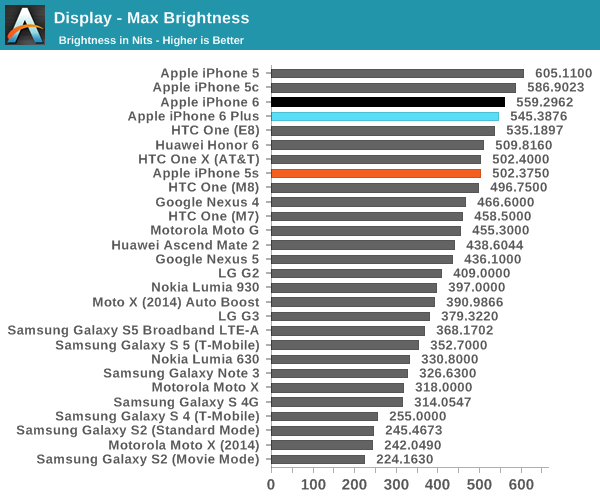
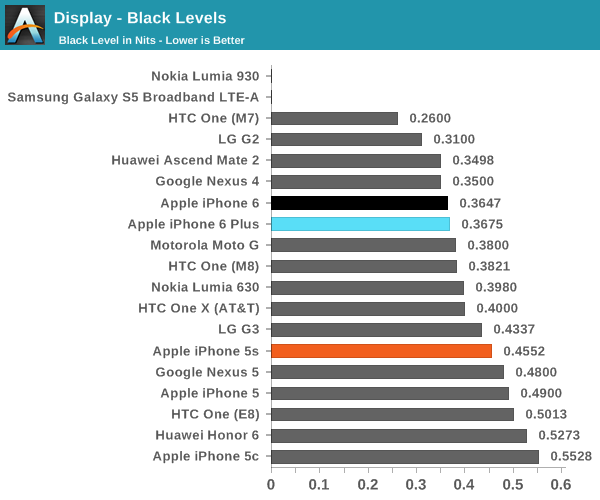
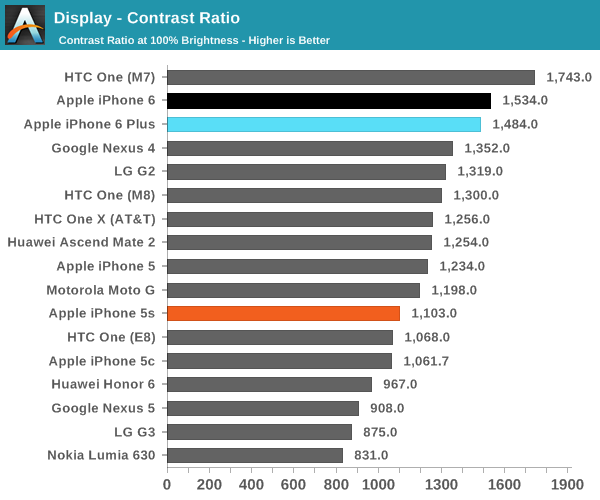
Our first test is of peak luminance and contrast. At maximum, the contrast difference between the iPhone 6 and 6 Plus is relatively small, and the difference in peak luminance is relatively small as well. I suspect that this means that Apple isn’t quite at the point where backlight luminous efficiency is rapidly falling off the way it seems to at 500+ PPI RGB LCD displays.

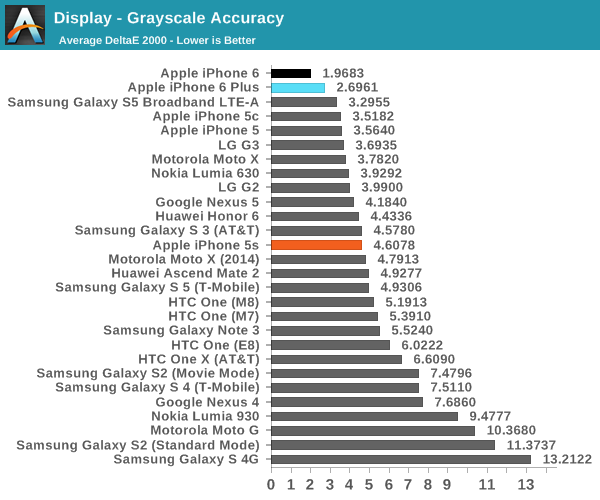
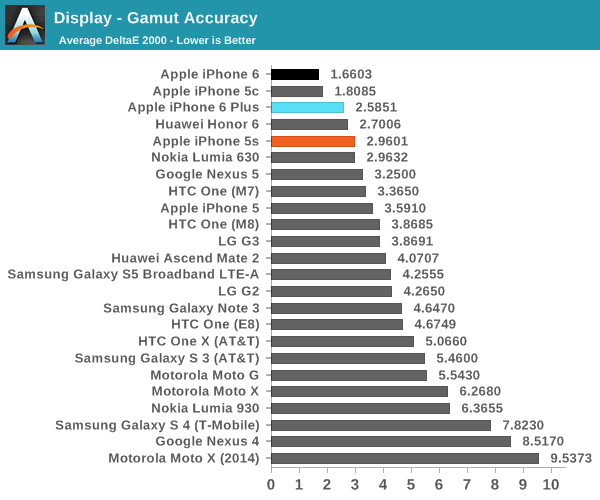
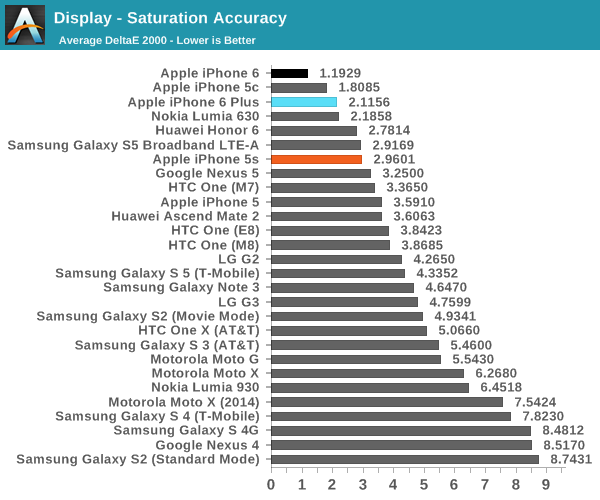
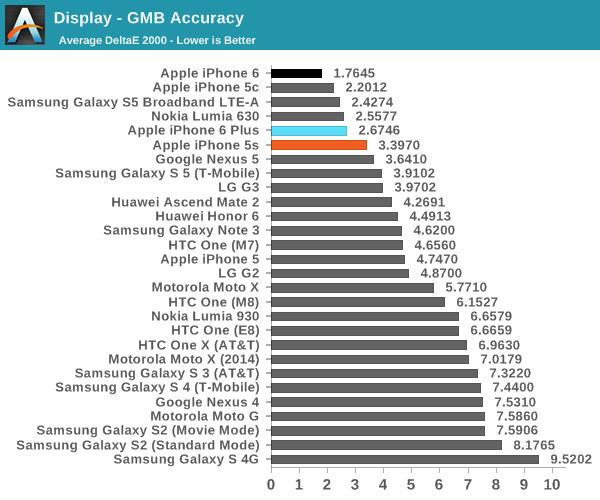
While I normally walk through each type of calibration test, there’s relatively little need in this case as the iPhone 6 Plus is close to the iPhone 6. There are some differences and the iPhone 6 is nearly perfect while the 6 Plus ends up being better than the 5s but not quite at the same level as the 6. I suspect this could be due to production variance, but these are different panels so without additional test units we can't say for certain. The iPhone 6 Plus display is quite close to the iPhone 6’s display in most regards, only larger; this is effectively as good as it gets for an LCD display.
Camera
Ultimately the change to the camera is the one difference that really sets the iPhone 6 and 6 Plus apart outside of the change in size. This one difference is optical image stabilization, or OIS. However, at first it's almost impossible to tell whether OIS is active. As someone who has used multiple cameras with OIS, this is a very odd sensation. Normally, OIS means that it's possible to see the effect of reverse accommodation in either the camera preview or while recording video, but I never saw these effects while recording video, whether in daytime or at night. In fact, I'm not even sure that video is ever optically stabilized, as seen in the videos below. I'm not sure why Apple chose to do this, as video recording is already cropped and would hide most of the odd effects that occur at the edges of the field of view when using OIS.
Putting aside OIS in video, it's obvious that the one area where OIS would be put to use is low light photography. Examining the EXIF data of low light photos, I was rather surprised to discover that in single shot mode (burst mode caps shutter speed to 1/15s) that the iPhone 6 Plus never exceeds 500 ISO. However, in order to keep pace with the iPhone 6's maximum of 2000 ISO and 1/15s exposure time, the iPhone 6 Plus drives exposure time as far as a quarter of a second, which is four times as long.
I really can't emphasize how incredible it is that Apple has pulled this off as it felt like something was wrong when I was testing low light photos as seen below. Normally, such a long exposure time entails noticeable trade-offs, but as far as I can tell motion blur is close to what I see on the iPhone 6 in low light. This seems to be the product of the multiple exposure combination that was mentioned in the keynote, and it really does work as advertised. While some benefit can be seen in the lightbox shot above, it's really in low light conditions like the photo below where we see significant benefits.
As you might expect, there's not much difference in daytime photos. I'm guessing that OIS is disabled above a certain shutter speed in order to reduce the distortion and blurriness that can come from OIS.


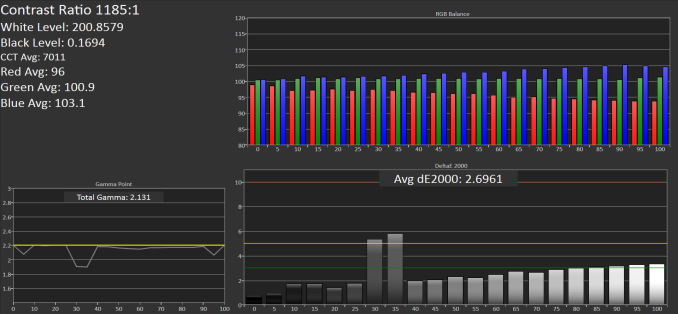
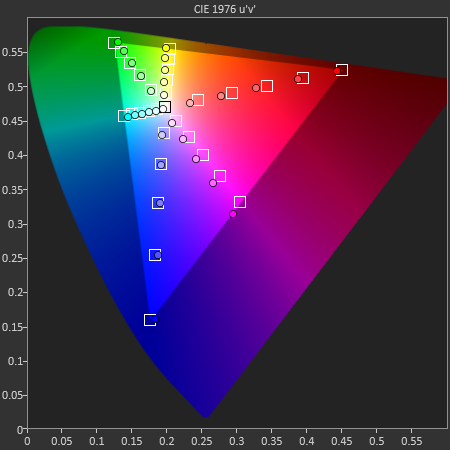
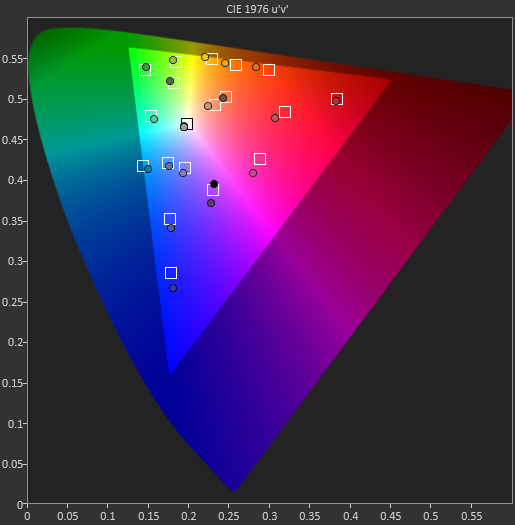






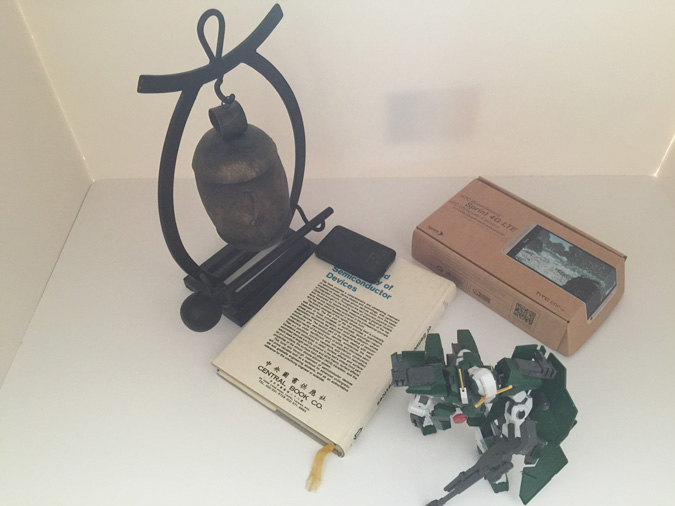






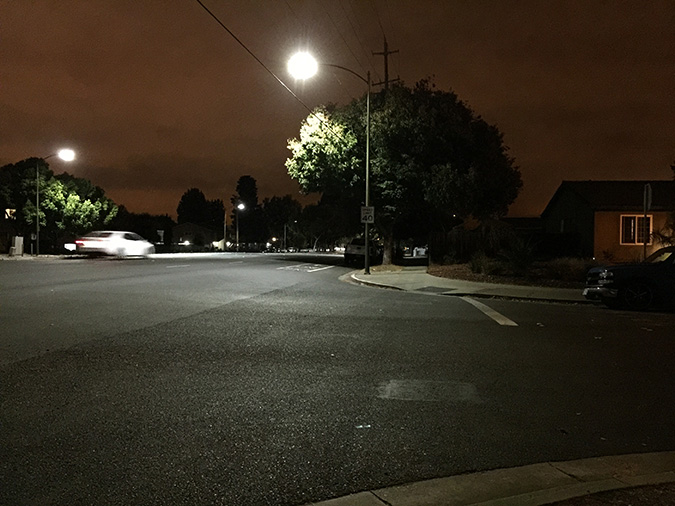






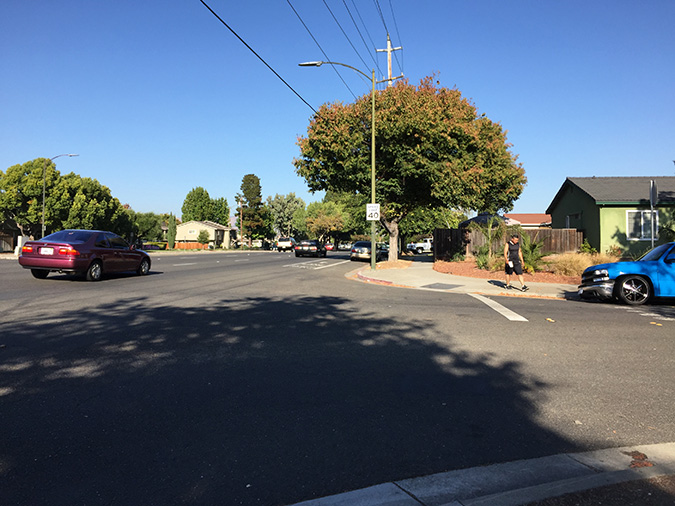








191 Comments
View All Comments
flutberf - Wednesday, October 1, 2014 - link
Android is incredibly secure. The only possible way it can get a "virus" (which on an android cannot happen anyway because of the permission system) is if someone disables 3rd party apk installs and downloads an app outside of the Play Store. Android being "open" has nothing to do with it.Also, maybe you get 10 times more calls for android phones than others because they have the vast majority of the market share?
Marthisdil - Thursday, October 2, 2014 - link
Right - because IOS has been able to be jailbroken via software since the beginning of time...IOS could have those similar bugs, especially once jailbroken...
I support hundreds of users and their devices, too. I get more calls on iphones than android phones.
yes, crapple sucks.
do i win now?
akdj - Wednesday, November 12, 2014 - link
'do i win now?'Or Do I win now?
Neither. iPhones outsell their flagship android counterparts many MANY times over. Most Android handsets are free, pay by the minute or 'tracphones'.
I love my Note 3. I've huge respect for what HTC, LC, Samsung...now, even Oppo. A name I thought only I was familiar with as an audio/video geek! ...HUGE Respect for each of their products, design choices in some cases are skeptical but the innovation that's 'pushed' BOTH Sammy and Apple to innovate, stay 'in front' of each other with the SoC races and THIS is a GOOD thing
A) you're either full of it, servicing Apple's 'hundreds of users and their devices too...and (sic) getting more support calls on iOS than Android' ...how would I know?
You're dealing with 'jail breakers' or those that brick their shit doing what they don't know how to, shouldn't be attempting and you're the only one that'll help them. Apple doesn't support jailbreaking their OS. Lotsa work goes into iOS, the App Store and payment to its developers. No reason they should. As well, jail breaking is essentially a thing of the past. iOS 8's capabilities far exceed Cydia's enticing possibilities earlier in iOS's life cycle. These days not much compelling other than side loading, screwing your device up or 'stealing' software.
None of which most buyers of an iPhone or iPad are interested in doing ...or should j say most?
Apple supports Apple. Not you. IF you're an IT manager and are operating a 'mixed' BYOD business, it's all about YOU. What you're using as your 'mainframe' (Linux? Windows? OS X?) & how you're allowing access to said workplace from outside or via VPN
I've owned every iPhone. A dozen Android phones and tabs and can honestly declare your post bullshit. Other than driving over, diving into water with, or blatantly destroying your device using software hacks/jailbreak methods beyond your scope of wisdom are all dumb, foolish things to do to a thousand dollar computer.
Why would you do it with your thousand dollar phone ...that IS a computer?
nerd1 - Wednesday, October 1, 2014 - link
Had iPhone 3gs and iPad 1. Now using android flawlessly (been through from 1.6 to 4.4)I just don't understand why people keep saying android is buggy. Apple devices were in fact more buggy to me (sudden app crashing, 'infinite apple logo' booting issues, freezing from now and then) and I had to jailbreak it to make it any useful, which brought even more bugs and issues.
Common sense - if android is too buggy to even make a call, nobody will buy android. Period.
moose0422 - Thursday, October 2, 2014 - link
I mean maybe it was just the phone I bought but Android is buggy. My Moto X wasn't the highest specced phone out there but the fact that it virtually ran the stock Android experience was what brought me to the platform. I unexpectedly became so frustrated with the OS that I had to go back to the iPhone. Between the lag, the crashing of apps, the unresponsive keyboard and random reboots I just couldn't take it anymore. Believe me I loved a lot about what Android offers. It has great features that iOS can't compete with but the overall experience just isn't the same.moose0422 - Thursday, October 2, 2014 - link
I had the 2013 Moto X and let me tell you it was an awful experience. It was the second android phone I've purchased, the first being the Samsung Captivate, and it randomly rebooted, apps crashed constantly, and the battery life was terrible. There were plenty of cool features on the phone such as Active Display, but the constant nagging of the bugs I encountered really made me hate the platform. I was an iPhone user pretty much since it was released and just recently went back to the iPhone 6 and couldn't be happier. The type of bugs I came upon just don't exist on iOS (even though it does suffer from some they are not nearly as annoying as those on Android 4.4.4). I'm hoping that Android L fixes a lot of those because the OS has a lot going for it in terms of being so open and customizable, but I was hardly impressed with my experience on KitKat and I feel that Google has lost me as a customer for foreseeable future.kmmatney - Thursday, October 2, 2014 - link
I used iPhone for 4 years, and now an Android phone for the last year. My Android phone (high end) has had a lot of bugs - serious things like not having it pause for 10-15 seconds between every word while trying to type an email (using default client). It wasn't until about a month ago that updates to Kitkat finally solved most of the issues. If I was at 2 years, I'd already have an iPhone 6+, but I'm too cheap to pay an early upgrade penalty, or buy one outright. I'm too cheap to even have a smartphone, but my work pays for the service, I just pay the subsidized phone cost. So after a year my phone finally works OK. My Nook HD+, on the other hand, well that's just buggy.OCedHrt - Thursday, October 2, 2014 - link
Because iOS doesn't show an error message when an app crashes ;)coldpower27 - Wednesday, October 1, 2014 - link
Yeah I had the S3 and switched to the iPhone 5, a much smoother overall phone. Android doesn't really come into it's own until you reach Samsung S4 and it's derivatives, and basically Note 2 and on. Android needs Quad Core for smooth operation on Samsung.If your using stock Android, the Nexus 4/5 has been a solid phone, though those are cheap phones and not really meant to compete with iPhone.
Narg - Wednesday, October 1, 2014 - link
I try so hard to convince people that if they need a cheap phone, stay away from Android. A good cheaper Nokia is a so much better experience. Android just doesn't work well on so many devices.